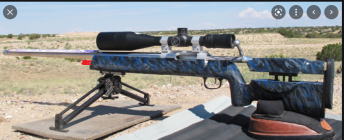This may be a difficult set of information/feedback to process. Someone's preferred stock specs will almost certainly depend, in part, on their body shape/size, their choice of bipod, etc., which means they will vary as much as the individual shooters vary.
Having said that, I am a big fan of the McMillan A5 stocks, those being what I started out on and continue to use. A couple years ago, I had a rifle build that necessitated a carbon fiber stock large enough to accommodate a much larger action footprint. Ultimately, a McMillan A5 "BR" carbon fiber stock was used for the build. However, I have never been able to shoot this rifle as consistently as my other F-TR rifles, an issue I have narrowed down to the difference between the [slightly larger] size of the pistol grip on the "BR" A5 carbon fiber stock, and the standard fill A5 stocks on the other rifles. My point is that something seemingly as minor as a slightly larger pistol grip changes the point on my finger where it contacts the trigger and has proven to be a real struggle for me to operate consistently. When it comes to your specific stock, even very small details can make a difference.
Although I heartily approve of most of the features on the standard A5 stock, there are a couple things I would change. I know the A5 was never intended specifically for use in F-TR, but the butt-hook and angled toe are something I would do away with. I would also lengthen the fore-grip by at least a couple inches, and potentially reinforce the barrel channel a bit to keep similar stiffness in the longer fore-grip. Generally, the farther forward the bipod is attached to the fore-grip, the more tolerant the rifle will be to operator movement at the rear. My impression is that many of the stocks in common use amongst F-TR shooters all suffer from this issue; i.e. the fore-grip is too short. If you take a look at something like the Manners F-Class stock, or one of McMillan's F-Open stocks with the "pickle forks" extending forward, you will have some idea of how much shorter the fore-grips on many F-TR stocks really are. Obviously stiffness and weight are two considerations when lengthening the fore-grip, but I think there is still some headroom for this in many F-TR stocks.














